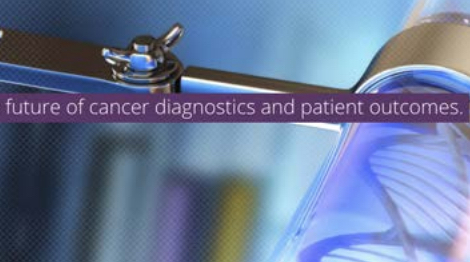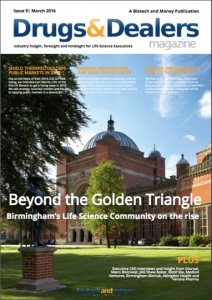Growth through commercialised tech and acquisitions
Biotech and Money had the opportunity to speak to Neil Campbell of Helomics about growth through commercialised tech and acquisitions. Neil Campbell serves as President and CEO of Helomics™. He is also an Advisor to HealthCare Royalty Partners; Chairman for Mosaigen® Corporation; Chairman for KidsRgenius®; and Senior Research Fellow at University of Liverpool in the United Kingdom.
B&M: Neil, please can you give me your 60 second elevator pitch, what is Helomics, and what makes it different?
NC: Helomics is the next generation of healthcare in oncology. Our mission is comprehensive tumour profiling. Everything we do is centred on the patient and the biology of tumours, and we achieve comprehensive tumour profiling through a combination of live and fixed cell analysis. What makes us unique is that we analyse the live cells while they are still growing and alive - they’re all patient specific. Our platform of uniqueness is live cell analysis and the reason for that is you can see things in live cells that you don’t see in fixed cells.
B&M: How are you hoping to create value?
NC: Let me answer that by explaining our choice of logo. Our logo colours are orange, purple and grey. The purple is the colour of cancer survivors. The orange is the colour of cancer research from university, industry and government. And the grey is the answers in cancer research are shades of grey, not black and white. Then the logo is the triple helix - the interface between government, industry and academia to try and find answers. Innovation models, KTI’s.
Everything we do is about the inner relationship of what government is trying to do, what universities are trying to do, and what industry is trying to do. We are creating value by bringing it all together, in our case around comprehensive tumour profiling. Utilising the live cell platform to be as personable as possible in understanding and characterising a patient’s tumour.
B&M: We’re Biotech and Money, so as our name would suggest, we are interested in people’s fund raising stories and what’s unique about them. We’ve done some digging, and we found out your company has used just about every fund raising vehicle in the past 20 years. Are there any stories or highlights or pivotal points from the fundraising journey that you could talk about?
NC: I can’t speak too much of the experience prior to when private equity became involved, but probably every financing vehicle available has been tried. A sizeable amount of money went into the company. Which is very good because they spent this money to build out this technology.
In the private equity world those valuable assets that are solid for the core technology or science are usually called diamonds in the rough. Great science, but for whatever reason the execution wasn’t where it should it be. So what you try to do is find diamonds in the rough that you can cobble together and buy and then build. Make or buy. Sometimes making can take twice as long, three times as long. So in this case we’re buying and building and licencing to build a company very quickly to try and consolidate the fragmentation. The funding that went in last fall, in the press release was $60 million, and it recapitalised the company from the VC’s that were in it before. The current private equity group is a majority owner of the company. Now what we’re doing is moving towards increasing – doubling - our revenue. The idea is to continue to build very quickly the company and then take it in to a liquidity situation, most likely IPO if the markets are receptive. But we’re also in parallel tracking to look for acquisitions.
B&M: Do you have a time frame for that?
NC: This fall to winter.
B&M: Potentially IPO this fall?
NC: It could be. It depends on the markets. And we are not beholden to any particular market because we could do dual listing outside the US followed by US. All that is kind of up in the air. Given the volatility of the current market we might choose to do an acquisition of a public company. Not a reverse merger where it’s a shell but an actual growing concern with revenue product. What we want to do is bolt on a company that complements what we’re trying to do. In terms of product, technical capability, and R&D. And also contribution to top line revenue but also bottom line profits.
B&M: Ok. I want to go back to the space in which you operate, personalised healthcare. Sometimes people conflate personalised healthcare with personalised medicine. Perhaps you could clarify, what does the term personalised healthcare actually mean to you?
NC: So we chose personalised healthcare to represent the wholeness or aggregate of what knowing more personally about patient you could do. There’s prevention of illness up front. There’s diagnosis. There’s treatment management. And then there’s follow on or observation. Hopefully you never get the disease again. Each of those pieces represents different types of products and technologies for a company to develop and build and sell. They also represent different challenges to the healthcare system. They represent different challenges in risk situations for investors.
We view it as more the totality of personalised approaches. Stratified medicine, precision medicine, personalised medicine, is all about a drug. And it’s about tailoring the drug to the patient and having a better understanding and outcome of the patient.
What we’re concerned about is costeffectiveness, having best safety profiles so you don’t have long term problems when you treat a patient, and then putting the right drug. But also too can we then broaden it to healthcare. So could I give you neutroceuticals or drinks or beverages that can make you live healthier, because you are what you eat, for example.
There are companies like Unilever, Danone, Nestle for example that are channelling huge efforts in trying to get more personalised medicine foods. They don’t look at it as medicine so much as personalised food. As a market evolves, we evolve with the market. So we chose personalised healthcare for a reason.
B&M: As you understand it, what do you think are the principle challenges that stand in the way of delivering truly personalised healthcare?
NC: You would think research and development, bringing technology to market and commercialising would be the biggest challenges. Ironically, the biggest challenge today in personalised healthcare is the ability to get the healthcare system and all stakeholders to play together to bring these products, services and technology to market.
The overriding problem I see, is that the advancement of technology is so rapid, and so inter-disciplinary today, that it’s hard for the healthcare systems, GPs and physicians to embrace and accept a tsunami of information and applications of product in their current every day to day practice. How does the healthcare system pay for that? How do they know something is worth it when it’s doubled in price? Does the economic benefit outweigh the increase in cost? Those are the challenges that I think besiege all healthcare systems in developed countries. Then it’s a whole other set of challenges on top of that in developing countries. China, Brazil, India, are countries where their middle class is growing. And many of their healthcare systems have aging populations. As their healthcare systems are emerging and developing they’re being hit by all these needs and even greater challenges. How do you take technology from other parts of the world and bring them successfully into your ecosystem? And if the challenges like in the UK, US, Canada, continental Europe, are difficult, can you imagine emerging countries? The analogy I sometimes use is it’s like drinking water out of a fire hose.
B&M: Your view is that the UK is on the cusp of achieving something quite incredible with personalised healthcare, and that this differs markedly to how it’s progressing in the US. Firstly can you define what are the differences between UK and US as far as personalised healthcare is concerned? And then perhaps look at why is it the UK is such a unique opportunity?
NC: Firstly, I think the UK is one of the best kept secrets in the world for advanced science and technology. Its universities are world class. The technology, the science, the research done in the UK is at one point very applied and very commercially orientated, but is also very seminal basic in nature. So what permeates out of the universities are usually fairly disruptive, but could be implemented into society fairly shortly or quickly.
The UK is very good because it has this commercialisation eye for how technology could be utilised by society. And as they do the research and as the research becomes more applied, they’re always thinking of the applications in society. In the US we sometimes have too many resources in terms of funding or capability in Universities that makes an attitude of ‘ there will always be money there, always be the opportunity’ prevalent. And sometimes the hungriness, passion to get something to be commercially viable sooner in research is not so prevalent in the US.
I think the other key difference is that the UK university system is more critically reflexive in its thinking. It thinks about impact before it occurs. It thinks about optionality. In the US there’s not that depth of training in perspective outlook. So when you start looking at developing science and technology, people are very holistic but focussed in the same time. Whereas in the US it’s very narrow. It doesn’t see the overlap. Those are very basic elements that I think allows the UK to be extremely entrepreneurial in terms of technology development. And of course there are some wellknown people. You’ve interviewed some people in your journal, that are extremely entrepreneurial and would be successful anywhere in the world, where there’s an ecosystem of support.
I think being over here allows you to see things operate differently to you would say in America. And I think unfortunately historically a lot of good technology has gone to the states where it should have stayed here. There’s not a strong capital market here as much as the US, and the underlying private equity, venture capital and angel investment has gone through cycles since the 1980’s. The VC’s started in the US in the 80’s, and really the model that has never been replicated in the world is the Cosmo model in Israel. New Zealand tried to replicate that whole thing country wide and Australia tried it, then the US tried a version of it. So you need the triple helix. You need strong support from government in enabling approaches, but let the commercialisation occur. And universities have to be very basic in applied research at the same time. They have to engage with the public, society, industry and government. That triple helix is much more effective I believe in the UK than in the US. It’s much more diffused, diluted in the US.
B&M: So, if that triple helix as you say is prevalent here in the UK, and exists very strongly, why isn’t it taking off just yet? I mean we seem to be perennially on the cusp of taking off with personalised healthcare. But significant challenges still remain.
NC: Well I believe the UK leads the world currently in personalised medicine, healthcare, whichever you want to call it. In terms of technological capabilities. The NHS, as much as when you read about it in the paper, people complain about it, it’s a model that allows you to implement personalised healthcare in a broader way than you have in any other healthcare system in the world. You can get access to patient information that you would never have anywhere else. You can have patients be better consumers of their healthcare by getting them involved through the NHS and all the other mechanisms that exist. And in the end I think the UK is driven to try to find a way to do UK PLC. How do you bring the triple helix to life? How do you get the government to not interfere but enable? How do you get the universities to still do basic research, because they’re still institutions of learning? But at the same time how do you get them to enable the advancement of basic science and technology? That’s the applied knowledge transfer. Then how do you get industry to understand they’re not the innovative ones? The ones that are really innovative are the universities. So by working tighter they will take that innovation and improve upon it.
And that interaction I think does really well here in the UK. And that’s why when you look, everyone points at the UK for models. NICE is trying to make healthcare affordable, trying to make it acceptable, and it’s trying not to bankrupt the country it is in. No other country in the world wants to have a healthcare system that is out of control, they can’t afford it, it’s not helping the patient population. In the end they can’t afford to have it. So I do believe the UK is today the foremost premiere in the world for personalised healthcare. But when I look at where it is going, it’s still far ahead of everyone else including the US.
B&M: I believe I read you have a formal partnership with Genomics England. Could you elaborate a bit on the nature of that partnership and what you hope to achieve through it?
NC: We’re part of Genomics England Ltd, (GEL, is the overall riding group.) Within the group there is what is called the GENE Consortium. That Consortium is an initial member list of 10 companies. There are 9 very large pharma and biotech companies, and then ourselves - by far the smallest. And we’re the only diagnostic company personalised medicine within that group. It’s 100,000 cancer genomes over the next 3 years, 2015, 16 and 16. The goal here is to sequence and generate data from these 100,000 genomes to better understand the personalised nature of certain types of cancers and rare diseases. And so it’s an effort in generating data that will be mined for the public good to help come up with new drugs, new diagnostics, and hopefully new… you know it could be food and beverages in the long term, to help make the patient population or the population healthier, when they become a patient treated better, quicker.
As I was personally involved in the sequencing of the human genome, a very global historic event, in 99 and 2000 when I was at Celera Genomics, we realised that even if you have this information, you elucidate things, there’s still so much more you don’t know. So it’s always, always an exploration process. This particular programme is historic in nature. And it will be unprecedented I think for a long time in the ability to collect holistically an enormous amount of data for the benefit of society. Then not just the UK, but everyone in the world will have access and collaborative arrangements within Genomics England. And that then helps make it importable, what’s happening here.
It’s so exciting. And sometimes I think the public doesn’t deeply appreciate the impact it’s going to have on future generations, their kids, their grandkids. But you have to start somewhere. And society benefits from this, but society is also the lynchpin of making this work. If these people weren’t donating their specimens and working within this we wouldn’t be able to do this.
B&M: Ok. Before we conclude the interview I want to bring it back to Helomics, and talk a little bit about where you’re going to be going with Helomics in the foreseeable. Firstly what is the epitome of success for Helomics? What’s the most desired outcome?
NC: Our goal is to empower physicians and their care team to give the best possible care to a cancer patient as possible, with the best insights, so they can make the most informed decisions.
At the same time we want to make sure cancer patients are more aware of their options, so they become a better consumer of their healthcare choices. When you bring the two together, our goal really is very simple. We have a lot of cancer survivors, and people affected by cancer working in our company. And the motto and mission we have internally is we want to give every patient, their family, as many birthdays, graduations, anniversaries as possible. If you can live for 2 more years or 10 years, see your children grow, go to university, see your kids marry, celebrate your wedding anniversary, that makes a big difference. That’s ultimately why we’re doing this.
B&M: And from a business/ commercial point of view? You mentioned you have a deal track process at the moment, IPO or acquisition, what do you view in the next 6 to 12 months as the main catalysts of the business? What can we expect to hear from Helomics?
NC: Helomics was formed through an acquisition on September 23rd last year. We will be announcing soon the next phase of our growth strategy and what we will be doing. But the idea is to rapidly add new technologies, new markets, and continue to expand what we do in live cells. We will be expanding what we call PCAP, Precision Cellular Analytical Platform. We’ll also be expanding the ability to analyse or comprehensively characterise a patient tumour. Concurrent to that we’ll be perusing 2 different tracks of fundraising, with the idea of going public.
The premise of this was buy and build. Build assets that are diamonds in the rough, that others don’t see the value of, that are solid technically, scientifically. And then surround it with people who can execute. Then build a personalised medicine oncology business. We’ve got a very substantial one now. It’s growing. We’re the only ones in the world in what we do. So we’re going to use that as an enabling lynchpin if you will to do partnerships that are very creative in nature.
Neil Campbell serves as President and CEO of Helomics™. He is also an Advisor to HealthCare Royalty Partners; Chairman for Mosaigen® Corporation; Chairman for KidsRgenius®; and Senior Research Fellow at University of Liverpool in the United Kingdom.
Helomics™ Corporation is a comprehensive personalized healthcare company, bringing the next generation of diagnostics to the oncology field. We are dedicated to improving patient outcomes by utilizing a proprietary set of laboratory platforms and our Science as a Service commercialization model to allow physicians to characterize malignant tumors. Our novel molecular and cellular markers and bioinformatics services are designed to support treatment decisions.





Leave a comment